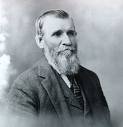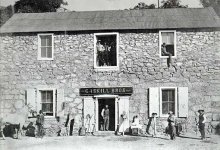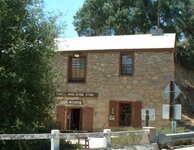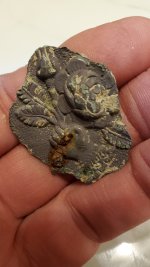pegleglooker
Bronze Member
- Jun 9, 2006
- 1,857
- 237
- Detector(s) used
- ace 250
- Primary Interest:
- All Treasure Hunting
Hey Gang,
I got all this from several places.. Has some really cool stories
PLL
Early History of Campo
They traveled west via Yuma making the difficult trip through the desert and rugged mountain trails with heavy wagons drawn by ox or bull teams and in a number of places had to build the road ahead. Charles F. Emery, at Campo as a boy in the 1870's, recalled the Burgesses, L.N. and Henry Bailey, the Gaskill brothers (Silas and Lumen), John and Alonso Warren, Jophn Speck, A.P. Herrick, Hochensmith, Chowning, the Clymes, Grays, Haydens, Morrises, and Livingstone - nearly all from Texas. Ella McCain records that "one of the first settlers in Campo Valley was Adam Lawrence and his family who came from Texas in 1866. He filed for homestead but returned to Texas later. 4. Charles H. Cameron, still living in Campo in 1945, recalled for Guard D. Gunn that his family came to Campo in 1868 and the Gaskills and Warrens proceeded them, Joseph A. Warren arriving in 1865. The Camerons and Warrens were pioneer sheep and cattlemen.5.

The Gaskills arrived in the spring of 1868 after several years of homesteading and setting out an orchard and vineyard at San Bernardino and then purchasing a thousand acres at San Jacinto for farming and bee culture. At Campo they purchased large tracts of land and promptly established the town (1.3 miles north of the International Boundary) by building the first store, blacksmith shop, grist mill and other enterprises.
They also raised cattle on a range extending into Mexico and Lower California. They developed apiaries of about four hundred colonies that in one summer produced over thirty tons of honey, the second largest output in the United States at that time. being exceeded only by their friend J.S. Harbison of San Diego.6. The Gaskill's merchandise was supplied from the San Diego area by horse-drawn wagons.


LATER EVENTS AND DEVELOPMENTS
1870 - 1895. Writing for "The Southern California Rancher" In June 1945 Guard D. Gunn quotes Charles H. Cameron's personal account of the early events including the famous raid on the Gaskills: "I knew Lumen H. Gaskill and his older brother Silas E. Gaskill well and I'll tell you the true story of the raid on their store, and of the stone store building which the County has made into an historical monument. There was a band of Mexican horse thieves that operated on both sides of the Border and as far north as San Joaquin valley. They would steal horses one place and sell or trade them someplace else. One day five of them crossed the Border on horseback, aiming to rob the Gaskill store which at that time was a frame building straddling the creek where the bridge now is. They tied their horses under some oak trees a short distance away and started to the store. Seeing Lumen in the store, they fired at him and wounded him. He fired, back and wounded one of the Mexicans, then dropped into the creek through a trap door in the store floor. The trap door was used to let fresh meat, butter, eggs, etc. into the cool creek waters - sort of like a refrigerator, you know. Lumen figured he could run to a nearby building and get another loaded gun and keep on fighting. Silas was working in the blacksmith shop back of the store when the fracas began, and running around the side of the store with his gun he wounded another Mexican. Lumen got a third bandit, then the other two ran to their horses and galloped away, leaving their three wounded companions. The captured bandits were put in a cabin near the store and Jimmy Keys was left to guard them. That evening a bunch of cowboys driving some cattle through the country heard of the shooting and came over to Campo. It was a cool evening and about dark they went to the cabin and offered Jimmy a drink of whisky to warm him up a bit. Jimmy took it and was soon fast asleep but the cowboys loafed around until nightfall. Next morning when Jimmy awoke, the cowboys were gone and the three bandits were hanging to a big oak tree nearby. Their bodies were buried near the creek and later the bank washed in and all trace of the graves lost. But the old tree still stands just inside the gate of Camp Lockett (on the south side of the street opposite the present East County Lumber and Ranch Supply building, but now a dead trunk with most of the top cut away). The Mexicans who escaped continued their escapades elsewhere. The old frame store was torn down long ago and the present stone store building was built by the Gaskills in 1885 - I know the date because I helped build it. It took two years to finish it."
The raid at the old wood frame Gaskill store occurred December 4, 1875. Cruz Lopez was the leader of the band; Jose Alvijo and Raphael Martinez were hung. Lopez died of wounds a year later, having been shot by a French sheepherder who had ridden up just in time to be mortally wounded himself. Alonzo Coto was the only bandit to escape without wounds.7.
Word came to Campo May 1876 that approximately one hundred bandits gathering in the Tecate area planned to rustle Jacumba stage station keeper Pete Larkin's cattle, "clean out" the Gaskills for food and ammunition and revenge the losses in Lopez band at Campo the previous December. Twenty settlers assembled to reinforce the small cavalry detachment detailed from San Diego to "outpost" duty in the mountains along the border to protect the mail stages and telegraph line. Colonel Barnard in command at San Diego arrived with additional cavalry troops. With that combined presence, the bandits did not follow their original plan. Scouting toward Jacumba, Barnard did find several hundred armed Mexicans and Indians (some Indians were still using bows and arrows) scattered among the rock formations on the Mexican side of the international border. Barnard, minimizing the danger, soon returned to San Diego with his command but left a squad to guard Pete Larkin's ranch and stage station. The bandits did continue to rustle his cattle for a time before drifting away.
In 1877 two Mexican horse thieves passing by near the Campo valley school house took Andrew and Zachary Elliott's prized horse tethered outside. The boys immediately left the classroom, borrowed horses and joined by a young Mexican named Mellendez, gave chase. Mellendez obtained a permit from the Alcalde at Tecate for their pursuit into Mexico. The Elliott brothers finally caught up with the horse thieves and killed them. Before they could re-cross the Border a group of Mexicans captured them and took them to San Rafael (about 30 miles south of the border), charged them with murder claiming the Alcalde exceeded his authority in granting the permit. With that development, about a dozen Campo settlers went to the rescue. On the way they were ambushed by a larger Mexican contingent and also became prisoners. After several weeks of negotiation with Mexican authorities at San Rafael by the sheriff of San Diego and finally by a special commissioner appointed from Washington D.C., all were released but with much ill-feeling remaining on the U.S. side of the Border. The Mexicans had cut the telegraph line east and west of Campo and menaced the settlers. At that same time the support of the U.S. Cavalry was gone with their trek to Montana to join in the pursuit of Sioux Indians under Crazy Horse, still "on the loose" after the Custer massacre at the Little Big Horn river.
With continued depredation on Larkin''s cattle, Campo settlers went to an Indian rancheria near Jacumba to resolve the matter. A battle ensued with a party of about forty braves firing on them from rocky cover. The settlers killed one native in returning fire. Finally a truce was arranged with the death of the Indian offsetting the purported killing of cattle for meat. Larkin remained the unsatisfied loser.8.
Thievery, banditry and violence continued along the border area during subsequent years. Cold-blooded murders by Indians, Mexicans and U.S. renegades with only looting as motive were reported from time to time. Stages were frequently held up. Horse-stealing was well organized. Those taken in Mexico were driven north for sale in the Los Angeles area; those taken in the U.S. were run south into Lower California.
Campo settlers were threatened again in 1895 following a revolt at the Ensenada army barracks. Yaqui Indians were often pressed into the army by the Mexican government rather than imprisoned for their depredations. About forty such "soldiers" at Ensenada gained liberty by killing their captain, his wife and a lieutenant. They outfitted themselves with the armory's Remington rifles and ample ammunition. To return to their Colorado River homeland, they needed horses not available in Ensenada where they had been quickly hidden by owners. The Yaquis headed for the mountain country of Campo. Again, the Gaskills had received word and made ready with the ranchers in the area. U.S. Army Lieutenant Hubert with ten infantrymen appeared after a forced march of fifty miles from San Diego. The Yaquis reached the Adams ranch fifteen miles south of Campo shortly after that family fled for protection at Campo. Looting all the Adams left behind, but still on foot, the Yaquis then learned that Mexican Governor Villagrana with a posse and Captain Rodriguez with twenty militiamen were gaining in the chase. To elude their pursuers they changed direction from Campo to Tecate Valley. Rodriguez caught up with them a mile or two southwest of Jacumba and finally subdued them in battle.9, 10. Ed T. Aiken had purchased the Gaskill store in 1886 and after two years of operation sold it to the Klauber merchandising interests in San Diego. Henry M. Johnson became manager of the stone store with his brother, Murray, as assistant. They extended the business by developing a chain of trading posts at Potrero, Descanso, Tecate and Jacumba - later incorporated as the Mountain Commercial Company. Supplies were brought in from San Diego and La Mesa with a wagon drawn by four horses and later by freight wagon draw by eight mules.11.
1896 - 1915. The Gaskills operated the thousand acre Campo Ranch until 1896 when they sold it to Ed Aiken. Their cattle interests were finally removed to the Colorado River area where Lumen's sons continued the operation. In 1902 Lumen and Silas dissolved their partnership and established homes in San Diego.12.
I got all this from several places.. Has some really cool stories
PLL
Early History of Campo
They traveled west via Yuma making the difficult trip through the desert and rugged mountain trails with heavy wagons drawn by ox or bull teams and in a number of places had to build the road ahead. Charles F. Emery, at Campo as a boy in the 1870's, recalled the Burgesses, L.N. and Henry Bailey, the Gaskill brothers (Silas and Lumen), John and Alonso Warren, Jophn Speck, A.P. Herrick, Hochensmith, Chowning, the Clymes, Grays, Haydens, Morrises, and Livingstone - nearly all from Texas. Ella McCain records that "one of the first settlers in Campo Valley was Adam Lawrence and his family who came from Texas in 1866. He filed for homestead but returned to Texas later. 4. Charles H. Cameron, still living in Campo in 1945, recalled for Guard D. Gunn that his family came to Campo in 1868 and the Gaskills and Warrens proceeded them, Joseph A. Warren arriving in 1865. The Camerons and Warrens were pioneer sheep and cattlemen.5.

The Gaskills arrived in the spring of 1868 after several years of homesteading and setting out an orchard and vineyard at San Bernardino and then purchasing a thousand acres at San Jacinto for farming and bee culture. At Campo they purchased large tracts of land and promptly established the town (1.3 miles north of the International Boundary) by building the first store, blacksmith shop, grist mill and other enterprises.
They also raised cattle on a range extending into Mexico and Lower California. They developed apiaries of about four hundred colonies that in one summer produced over thirty tons of honey, the second largest output in the United States at that time. being exceeded only by their friend J.S. Harbison of San Diego.6. The Gaskill's merchandise was supplied from the San Diego area by horse-drawn wagons.


LATER EVENTS AND DEVELOPMENTS
1870 - 1895. Writing for "The Southern California Rancher" In June 1945 Guard D. Gunn quotes Charles H. Cameron's personal account of the early events including the famous raid on the Gaskills: "I knew Lumen H. Gaskill and his older brother Silas E. Gaskill well and I'll tell you the true story of the raid on their store, and of the stone store building which the County has made into an historical monument. There was a band of Mexican horse thieves that operated on both sides of the Border and as far north as San Joaquin valley. They would steal horses one place and sell or trade them someplace else. One day five of them crossed the Border on horseback, aiming to rob the Gaskill store which at that time was a frame building straddling the creek where the bridge now is. They tied their horses under some oak trees a short distance away and started to the store. Seeing Lumen in the store, they fired at him and wounded him. He fired, back and wounded one of the Mexicans, then dropped into the creek through a trap door in the store floor. The trap door was used to let fresh meat, butter, eggs, etc. into the cool creek waters - sort of like a refrigerator, you know. Lumen figured he could run to a nearby building and get another loaded gun and keep on fighting. Silas was working in the blacksmith shop back of the store when the fracas began, and running around the side of the store with his gun he wounded another Mexican. Lumen got a third bandit, then the other two ran to their horses and galloped away, leaving their three wounded companions. The captured bandits were put in a cabin near the store and Jimmy Keys was left to guard them. That evening a bunch of cowboys driving some cattle through the country heard of the shooting and came over to Campo. It was a cool evening and about dark they went to the cabin and offered Jimmy a drink of whisky to warm him up a bit. Jimmy took it and was soon fast asleep but the cowboys loafed around until nightfall. Next morning when Jimmy awoke, the cowboys were gone and the three bandits were hanging to a big oak tree nearby. Their bodies were buried near the creek and later the bank washed in and all trace of the graves lost. But the old tree still stands just inside the gate of Camp Lockett (on the south side of the street opposite the present East County Lumber and Ranch Supply building, but now a dead trunk with most of the top cut away). The Mexicans who escaped continued their escapades elsewhere. The old frame store was torn down long ago and the present stone store building was built by the Gaskills in 1885 - I know the date because I helped build it. It took two years to finish it."
The raid at the old wood frame Gaskill store occurred December 4, 1875. Cruz Lopez was the leader of the band; Jose Alvijo and Raphael Martinez were hung. Lopez died of wounds a year later, having been shot by a French sheepherder who had ridden up just in time to be mortally wounded himself. Alonzo Coto was the only bandit to escape without wounds.7.
Word came to Campo May 1876 that approximately one hundred bandits gathering in the Tecate area planned to rustle Jacumba stage station keeper Pete Larkin's cattle, "clean out" the Gaskills for food and ammunition and revenge the losses in Lopez band at Campo the previous December. Twenty settlers assembled to reinforce the small cavalry detachment detailed from San Diego to "outpost" duty in the mountains along the border to protect the mail stages and telegraph line. Colonel Barnard in command at San Diego arrived with additional cavalry troops. With that combined presence, the bandits did not follow their original plan. Scouting toward Jacumba, Barnard did find several hundred armed Mexicans and Indians (some Indians were still using bows and arrows) scattered among the rock formations on the Mexican side of the international border. Barnard, minimizing the danger, soon returned to San Diego with his command but left a squad to guard Pete Larkin's ranch and stage station. The bandits did continue to rustle his cattle for a time before drifting away.
In 1877 two Mexican horse thieves passing by near the Campo valley school house took Andrew and Zachary Elliott's prized horse tethered outside. The boys immediately left the classroom, borrowed horses and joined by a young Mexican named Mellendez, gave chase. Mellendez obtained a permit from the Alcalde at Tecate for their pursuit into Mexico. The Elliott brothers finally caught up with the horse thieves and killed them. Before they could re-cross the Border a group of Mexicans captured them and took them to San Rafael (about 30 miles south of the border), charged them with murder claiming the Alcalde exceeded his authority in granting the permit. With that development, about a dozen Campo settlers went to the rescue. On the way they were ambushed by a larger Mexican contingent and also became prisoners. After several weeks of negotiation with Mexican authorities at San Rafael by the sheriff of San Diego and finally by a special commissioner appointed from Washington D.C., all were released but with much ill-feeling remaining on the U.S. side of the Border. The Mexicans had cut the telegraph line east and west of Campo and menaced the settlers. At that same time the support of the U.S. Cavalry was gone with their trek to Montana to join in the pursuit of Sioux Indians under Crazy Horse, still "on the loose" after the Custer massacre at the Little Big Horn river.
With continued depredation on Larkin''s cattle, Campo settlers went to an Indian rancheria near Jacumba to resolve the matter. A battle ensued with a party of about forty braves firing on them from rocky cover. The settlers killed one native in returning fire. Finally a truce was arranged with the death of the Indian offsetting the purported killing of cattle for meat. Larkin remained the unsatisfied loser.8.
Thievery, banditry and violence continued along the border area during subsequent years. Cold-blooded murders by Indians, Mexicans and U.S. renegades with only looting as motive were reported from time to time. Stages were frequently held up. Horse-stealing was well organized. Those taken in Mexico were driven north for sale in the Los Angeles area; those taken in the U.S. were run south into Lower California.
Campo settlers were threatened again in 1895 following a revolt at the Ensenada army barracks. Yaqui Indians were often pressed into the army by the Mexican government rather than imprisoned for their depredations. About forty such "soldiers" at Ensenada gained liberty by killing their captain, his wife and a lieutenant. They outfitted themselves with the armory's Remington rifles and ample ammunition. To return to their Colorado River homeland, they needed horses not available in Ensenada where they had been quickly hidden by owners. The Yaquis headed for the mountain country of Campo. Again, the Gaskills had received word and made ready with the ranchers in the area. U.S. Army Lieutenant Hubert with ten infantrymen appeared after a forced march of fifty miles from San Diego. The Yaquis reached the Adams ranch fifteen miles south of Campo shortly after that family fled for protection at Campo. Looting all the Adams left behind, but still on foot, the Yaquis then learned that Mexican Governor Villagrana with a posse and Captain Rodriguez with twenty militiamen were gaining in the chase. To elude their pursuers they changed direction from Campo to Tecate Valley. Rodriguez caught up with them a mile or two southwest of Jacumba and finally subdued them in battle.9, 10. Ed T. Aiken had purchased the Gaskill store in 1886 and after two years of operation sold it to the Klauber merchandising interests in San Diego. Henry M. Johnson became manager of the stone store with his brother, Murray, as assistant. They extended the business by developing a chain of trading posts at Potrero, Descanso, Tecate and Jacumba - later incorporated as the Mountain Commercial Company. Supplies were brought in from San Diego and La Mesa with a wagon drawn by four horses and later by freight wagon draw by eight mules.11.
1896 - 1915. The Gaskills operated the thousand acre Campo Ranch until 1896 when they sold it to Ed Aiken. Their cattle interests were finally removed to the Colorado River area where Lumen's sons continued the operation. In 1902 Lumen and Silas dissolved their partnership and established homes in San Diego.12.




